National Parks and Climate Change
Air Date: Week of August 17, 2007
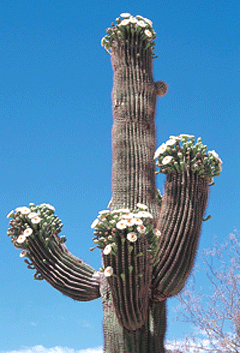
A saguaro cactus in bloom. (Courtesy of Arizona Game and Fish)
Our national parks are beginning to feel the effects of global warming. Mark Wenzler from the National Parks Conservation Association tells host Steve Curwood about observed and projected changes from melting glaciers and extinction of trees, to rising sea levels.
Transcript
CURWOOD: From the Jennifer and Ted Stanley Studios in Somerville, Massachusetts - this is Living on Earth. I’m Steve Curwood. You probably have a favorite national park or two. Hopefully, you took some pictures the last time you were there to help you remember what you saw, because experts are now telling us that many of our national parks not only provide habitat for endangered species, but themselves are endangered by global warming. The latest report comes from the National Parks Conservation Association. Mark Wenzler is the director of Clean Air Programs for the Association. I spoke with him about a number of national parks starting with the Everglades in Florida. There, billions of dollars have been dedicated to restoration, so I asked if that money will be wasted with rising sea levels.
WENZLER: If you have to single out one park that’s most at risk it’s got to be the everglades because in fact, close to a third of southern Florida could be under water by the end of the century and that would completely obliterate that ecosystem. I would say that it’s not that the investments we’re making now aren’t worth it because they are shoring up the ecosystem and they’re going to help it withstand that sea level rise to a greater extent than it could have before. But certainly there’s a tremendous amount of investment that’s going to go to waste.
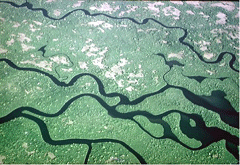
The Everglades in Florida may be underwater as sea level rises. (Courtesy of NASA)
WENZLER: It’s interesting to think that those parks, as hot as they are already, are going to suffer from additional heat but they will because the saguaro have adapted to live in a certain climate range and other species are kept out by that range. And as that range changes more species like invasive grasses will be able to move in. We see that happening now. And you really don’t have anything in those ecosystems right now that burns, in fact there have been very few fires in those ecosystems. But as these invasive grasses move in and dry out you’re going to see increasing amounts of wildfires that put the saguaro at risk.

A saguaro cactus in bloom.(Courtesy of Arizona Game and Fish)
WENZLER: Exactly. Anybody who watched Bugs Bunny in the 60’s or Road Runner has seen a lot of saguaro cactus.
CURWOOD: And what about Joshua Tree?
WENZLER: Joshua Tree is interesting. You know people often talk about ‘we’ll have to rename Glacier National Park because there won’t be any glaciers.’ But Joshua Tree we may have to rename as well because the trees are disappearing or are expected to disappear from the park by the end of the century. Those trees need a certain amount of cold weather to reproduce. I think it’s about one or two nights below freezing each year that help them release their seeds and reproduce. And that’s not going to be happening. They won’t be getting down to those temperatures. Those trees won’t be able to reproduce. Again you’ll have invasive grasses moving in to replace them. And certainly they’ll exist to a lesser extent outside the park but what’s predicted is within the boundaries of that Joshua Tree National Park we may not have any Joshua Trees.
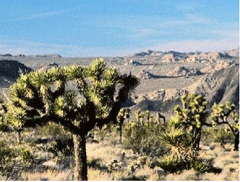
Joshua Tree national park may one day be without its namesake as the Joshua Trees migrate out of the park because of climate change. (Courtesy of USGS)
WENZLER: You know an interesting story is the grizzly bear at Yellowstone. People think of the grizzly bear and think what do they eat? Well they eat hikers, bear, moose, you know big things. But one of the most important food sources for grizzlies are pine nuts. And what’s happening is that the white bark pine beetle is becoming more prevalent as warmer temperatures take over the park. And they’re killing those trees. And there’s this unintended consequence where you know something happens and it changes something else and all of the sudden the grizzlies don’t have the food they need and they’ll have to move northward to find those trees that have those pine nuts.
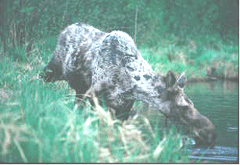
An increased number of ticks in Isle Royal National Park feed on moose such as this one. As a result the moose can develop anemia and alopecia. Those diseases kill the moose and negatively impacts wolf populations which feed on moose. (Courtesy of National Park Service)
CURWOOD: What are the other parks where you’re particularly concerned about invasive species and/or pests?
WENZLER: Well, you know you look at a park like Great Smokey Mountains National Park in Tennessee and North Carolina, and that park has already been very heavily impacted by invasive species like the adelgid, which have almost wiped out the hemlock trees. Climate change and warming temperatures are just going to make those kinds of pests thrive. And so it looks like we won’t be able to beat out the clock and save those trees. The adelgids are going to take off, they’re going to continue to decimate those forests.
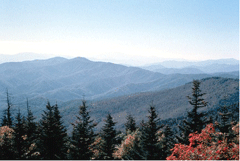
Great Smokey Mountains National Park is home to more tree species than in all of Europe. As the southern boundary for many of those trees some will leave the park as the climate warms. (Courtesy of National Park Service)
WENZLER: Well, that’s really bad. That’s probably some of the most dramatic changes that you can see today. You know people sometimes ask me “where can I go see climate change?” One place you definitely can see it is at Glacier National Park because you can go and see how extensive the glaciers were and how they’ve been reduced to almost nothing today. In fact I think we’ve only got a few more decades before they’re gone completely.
CURWOOD: Now Glacier of course is at risk. What are the other ones that come to mind?
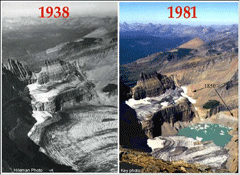
The extent of retreat of this glacier in Glacier National Park is documented by comparing photographs. Of the 150 glaciers observed in 1850 less than 30 remain today and those are expected to melt in the next 20 to 30 years. (Courtesy of National Park Service)
CURWOOD: This is all very gloomy here. What can we do specifically to help the parks?
WENZLER: Well, the parks are doing an interesting thing right now. The National Park Service just about a year or two ago began a program called Climate Friendly Parks. So, they’re doing things like investing in clean transportation systems, putting solar panels on visitor centers. They’re not just doing that for their own sake but also educating the public about what they can do at home.
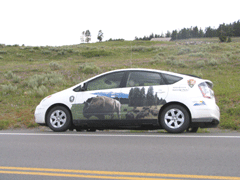
Some park rangers in Yellowstone National Park drive hybrid cars, like this Prius. Photo: Susan Trotz
And it’s a program that is growing. I think Glacier in Montana was one of the first, again given what’s at stake for that park. Zion down in Utah has some really innovative public transportation systems. Zion’s also got uh, being in the desert southwest, an extensive use of solar panels which is really interesting. Glacier Bay is also part of the Climate Friendly Parks program. And one of the big pollution sources up there are cruise ships. So Glacier Bay is working with the cruise industry to figure out how they can get them to reduce their emissions and protect the park. I guess if there’s any silver lining in this story it’s that it’s not too late to avoid some of the worst problems. And that’s why we’re trying to raise attention to this issue now. If we want to save these special places that tell the story of our nation and our shared natural history we’ve got to act now.
CURWOOD: Mark Wenzler is director of the clean air program for the National Parks Conservation Association and producer of their report Unnatural Disaster: Global Warming in our National Parks. Thanks so much Mark.
WENZLER: You’re welcome. Thank you.
[MUSIC: The Harvesters “This Land Is Your Land” from ‘Pastures of Plenty and Other Songs (Smithsonian Folkways Records - 1961)]
CURWOOD: To learn more about our national parks and climate change, go to our web site, loe.org. You can also get the inside scoop from Mark Wenzler about his favorite wild places, including some that most people don’t know about.
Links
Click here to listen to Mark Wenzler talk about his favorite parks.
Click here for a link to the National Park Service Podcast
National Parks Conservation Association
NPCA report on the effects of global warming in the national parks
Living on Earth wants to hear from you!
Living on Earth
62 Calef Highway, Suite 212
Lee, NH 03861
Telephone: 617-287-4121
E-mail: comments@loe.org
Newsletter [Click here]
Donate to Living on Earth!
Living on Earth is an independent media program and relies entirely on contributions from listeners and institutions supporting public service. Please donate now to preserve an independent environmental voice.
NewsletterLiving on Earth offers a weekly delivery of the show's rundown to your mailbox. Sign up for our newsletter today!
 Sailors For The Sea: Be the change you want to sea.
Sailors For The Sea: Be the change you want to sea.
 The Grantham Foundation for the Protection of the Environment: Committed to protecting and improving the health of the global environment.
The Grantham Foundation for the Protection of the Environment: Committed to protecting and improving the health of the global environment.
 Contribute to Living on Earth and receive, as our gift to you, an archival print of one of Mark Seth Lender's extraordinary wildlife photographs. Follow the link to see Mark's current collection of photographs.
Contribute to Living on Earth and receive, as our gift to you, an archival print of one of Mark Seth Lender's extraordinary wildlife photographs. Follow the link to see Mark's current collection of photographs.
 Buy a signed copy of Mark Seth Lender's book Smeagull the Seagull & support Living on Earth
Buy a signed copy of Mark Seth Lender's book Smeagull the Seagull & support Living on Earth

